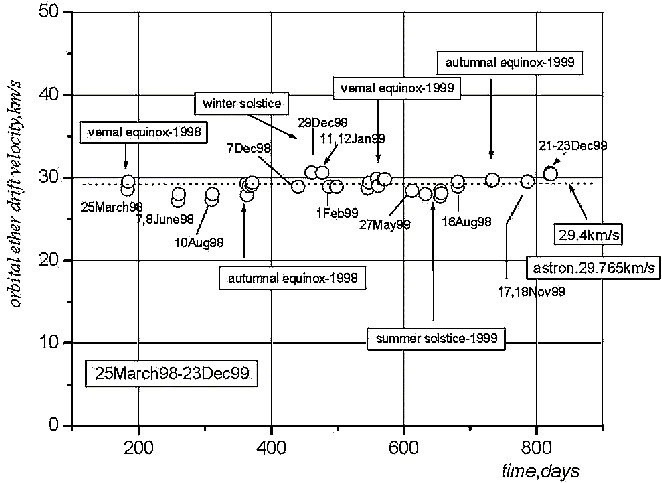There is some benefit to ID if even parts of the YEC hypothesis are confirmed, the most notable example right now is Sanford and Cos work which was presented at the Cornell Conference. In a previous thread, I discussed the distant starlight problem is a thorn in the side of YEC.
[the Vodka designation means the following material likely has errors but has data that are worth considering]

There are some experiments that have indirect bearing on the question YEC. Any experiment that may enable us to augment existing physics, particularly Einstein’s relativity and Maxwell’s equations is good for YEC, and thus possibly good for ID. But Einstein’s relativity and Maxwell’s equations have numerous experimental proofs ( unlike Darwinism). Much of the high tech world works because of Maxwell’s equations, and Einstein’s special relativity is consequence of Maxwell’s equations.
When we are in a moving car and put our hand out of the window, we can feel the air pushing on our hand and thus get a sense of our motion relative to the air. Airplanes use pitot tubes to sense an airplane’s motion relative to the air. A pitot tube protrudes from the nose of this fighter plane below:

But does space contain a substance (the Aether wind) that can be sensed as we move through it (like we can sense the air)? A famous experiment over 120 years ago suggested the answer is “no”, but a recent experiment suggests the answer is “yes” and this may force a change in our understanding of Einstein’s relativity and Maxwell’s equations.
The experiment 120 years ago is called the Michelson-Morley experiment. It attempted to sense the Earth’s velocity by sensing our movement through the Aether. The experiment was supposed to detect our movement through space around the sun at a speed of around 29.7 km/s, it did not, Michelson-Morley’s speedometer read zero! Thus Michelson did not find the Aether he earnestly sought, and with a broken heart, he accepted the Nobel prize in recognition for his failure to find the Aether. Ah, the irony!
Michelson’s experiment and others like it were used to support Einstein’s theory of relativity. There has been little reason to redo such experiments because Einstein’s theories (unlike Darwin’s) work so well. But that does not necessarily mean Einstein’s theories can’t be tweaked. 😈
Michelson-Morley 120 years ago and similar experiments thereafter may have left out one consideration, the effect of Earth’s gravity on the Aether! E.I. Shtyrkov of the Kazan Phys Technical Institute in Kazan, Russia carried out a modified Michelson-Morley experiment that took gravity into account. Shtyrkov claims he found the Aether that Michelson searched for. [I’ll let the reader decide the truthfulness of the claim over a glass of vodka…]
Shtyrkov’s experiment used geosynchronous satellites. And lo and behold, not only did it report a value close to the average velocity of the Earth moving around the sun at 29.4 km/s, it could even sense seasonal changes in the speed of the Earth as depicted in this graph. The X-axis gives the velocities over the hundreds of days the experiment was run, and the Y-axis is the velocity detected:

His paper is a tough read partly because it was translated into English from Russian and partly because of the technical nature of the work.
Measuring Parameters of the Earth Sun System
Here is Shtyrkov’s profile: E. I. Shtyrkov
Technical criticisms are welcome, but please be polite since I warned y’all that this could be in error. Thanks.
NOTES:
1. Here is a 3 minute video that explains the Michelson-Morley experiment (watch in full screen mode to see the details):
2. other essays on the topic:
Dissident view of Relativity by William Cantrell. An exceprt:
Silvertooth measured the standing waves formed by light beamed in opposite directions using two lasers. One of the lasers was phase modulated with respect to the other, creating certain phase effects that could be measured with a special photomultiplier tube. Silvertooth found a consistently privileged direction pointing to the constellation Leo, traveling at a velocity of 378 km/sec regardless of the time of day or year
…
It should be noted that Silvertooth published his results prior to the launch of NASA’s COBE satellite, whose purpose was to accurately measure the cosmic microwave background. Due to the motion of our solar system, a Doppler shift was discovered which imparts a slight anisotropy to the spectrum of the cosmic microwave background. Precise measurement of this anisotropy indicates that the heliocentric (Sun centered) frame moves toward the constellation Leo with a velocity of 390 km/sec, in excellent agreement with Silvertooth’s findings.
…
In 1991 another experiment appeared to confirm a galactic velocity component of the aether. Roland DeWitte carried out an experiment in Belgium involving two cesium clocks separated by 1.5 kilometers along a common meridian. A 5 MHz RF signal was generated from each cesium time-base. This produced two independent, but identical signals to within the limits of cesium clock drift. A long length of buried coaxial cable was used to send one of the RF signals down to the other end for comparison using a phase detector. DeWitte ran the experiment over a considerable time span of 178 days.The results indicated that an anomalous phase shift was present in the data, correlated to sidereal, not civil, time. With a period of 23 hours 56 minutes ± 25seconds (one sidereal day), this proved that the effect responsible for the phase shift was of galactic, not man-made, origin. It would be very interesting to repeat this experiment and also include a round-trip measurement to see if a null-result would be obtained due to round-trip averaging.
Less precise measurements were made using a 500 meter cable and rubidium clocks by Torr and Kolen at NIST.24 They observed an unexplained one-way phase shift which disappeared from the complete round-trip measurement. These one-way results are not predicted by Einstein’s theory, and it is hard to think of another mechanism or artifact correlated to sidereal time that would cause the results seen by DeWitte—certainly not thermal heating or human activity, which would be correlated to a mean solar day (24 hours).
Other experiments carried out:
Kinematic Waves Viscosity in Optical Wave Band by Yu Galaev (scroll to page 17 of 52).
2. Shtyrkov also suggested the speed of light was faster in the past:
The Evolved Vacuum of Redshifts
3. photo credits
http://globalbeauties.com/universe/wp-content/uploads/2012/12/russianstandard.jpg
http://farm3.staticflickr.com/2681/4171245655_35f6d4cccc_o.jpg
http://bourabai.kz/shtyrkov/img/bradl357.gif